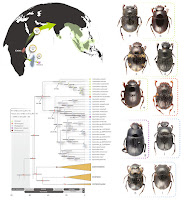 |
Species illustrated: (a) Ochicanthon hanskii Krikken & Huijbregts, (b) O. woroae Ochi, Ueda & Kon, (c) O. crypticus Krikken & Huijbregts, (d) O. devagiriensis Sabu & Latha, (e) O. ceylonicus Cuccodoro, (f) Grebennikovius basilewskyi (Balthasar), (g) Epactoides giganteus, (h) E. madecassus (Paulian), (i) E. major (Paulian), (j) E. frontalis (Montreuil). Rossini, Grebennikov, Merrien, Miraldo, Viljanen & Tarasov, 2022 DOI: 10.1111/syen.12564 |
Abstract
Paleotropical clades with largely disjunct distributions are ideal models for biogeographic reconstructions. The dung beetle genera Grebennikovius Mlambo, Scholtz & Deschodt, Epactoides Olsouffief and Ochicanthon Vaz-de-Mello are distributed in Tanzania, Madagascar and Réunion, and the Oriental region, respectively. We combine morphology and molecular dataset to reconstruct the phylogenetic relationships between these taxa. Our analyses corroborate previous hypotheses of monophyly of the group, which is here described as new tribe Epactoidini trib. nov. Grebennikovius is recovered as sister to Epactoides, while Ochicanthon emerges as sister to them both. The disjunct distribution of our focal clade is unusual within the subfamily Scarabaeinae. Bayesian divergence time estimates and ancestral range reconstructions indicate an African origin of the crown group of the tribe Epactoidini trib. nov. in the early mid Eocene, ca. 46 Ma. The divergence between Epactoides and its sister is dated to 32.3 Ma, while the crown age for the genus Ochicanthon is dated to 27 Ma. We investigate the factors that may have shaped the current distribution of the tribe Epactoidini trib. nov. The formation of the Gomphotherium landbridge, along with favourable environmental conditions would have allowed dry-intolerant organisms, such as Ochicanthon, to disperse out of Africa. Remarkable climatic stability of the Eastern Arc Mountains was critical for the retention of the monotypic genus Grebennikovius. We suggest two subsequent overwater dispersal events: the migration of the most recent common ancestor (MRCA) of Epactoides from Africa to Madagascar (32.3–29.5 Ma); the lately dispersal of the MRCA of the today's extinct Epactoides giganteus Rossini, Vaz-de-Mello & Montreuil to Réunion island from Madagascar (3.4 Ma). We suggest that the high potential of dispersal of Epactoidini trib. nov. dung beetles and the strict association to forest habitat might have triggered two major radiations, one in Madagascar and one in the Oriental Region.
Keywords: biogeography, evolution, phylogenetics
Epactoidini trib. nov.
Type genus: Epactoides Olsouffief, 1947
Genera: Epactoides Olsouffief, 1947
Grebennikovius Mlambo et al., 2019
Ochicanthon Vaz-de-Mello, 2003.
Distribution: Tanzania (Uluguru Mountains); Madagascar; Réunion Island; Oriental Region: from southern India to southern Philippines.
Diagnosis: The tribe Epactoidini is supported by the following diagnostic characters (Figure 2): (i) elytra with 9–10 striae; (ii) besides epipleural carina, elytra with one or two additional lateral carinas; (iii) endophallus without frontolateral peripheral (FLP) endophallite; (iv) radial posterior (RP1) sclerite of hindwings (when present) approaches the posterior side the radial anterior (RA4) sclerite.
Michele Rossini, Vasily Grebennikov, Thomas Merrien, Andreia Miraldo, Heidi Viljanen and Sergei Tarasov. 2022. Paleogene Forest Fragmentation and Out-of-Africa Dispersal explain Radiation of the Paleotropical Dung Beetle tribe Epactoidini trib. nov. (Coleoptera: Scarabaeinae). Systematic Entomology. DOI: 10.1111/syen.12564




